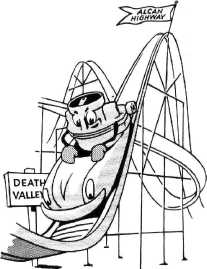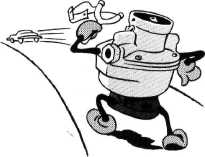The ABCs of Carburetion
UM-900 (1959)
Page 7 of 19
|
|
|||
|
THE CARBURETOR'S JOB Continued
|
|||
|
|
|||
|
FLEXIBILITY
Changes in engine and
air temperatures, altitude and manifold vacuum all affect the weight
and volume of the fuel and air. These factors and others may affect
the mixture and distribution to such an extent that combustion is
erratic or does not occur at all. The carburetor
must be able to anticipate and allow for such
changes so that a combustible mixture reaches the cylinder.
|
 |
||
 |
|||
|
<
MANEUVERABILITY
The carburetor
must satisfy the demands of a critical automobile operator, who
desires smooth acceleration, quick response to
rapid throttle maneuvers, quick starts and stops, proper operation on
steep inclines, in all kinds of weather.
|
|||
 |
|||
|
ACCELERATION
For acceleration,
additional fuel is needed momentarily for the transfer to a higher
speed. The principal reason for the need for
more fuel is the difference in weight of the fuel and air. When the
throttle is opened, acceleration of the air stream is nearly
instantaneous. The fuel, however, is many times heavier than air and
cannot accelerate as rapidly, so until the fuel flow "catches up" with
the air flow, the mixture is excessively lean. The accelerator
|
|||
|
pump supplies extra
fuel to offset this momentary leanness; without the extra squirt of
fuel at the right time, the engine sputters or hesitates.
|
|||
|
|
|||
|
7
|
|||
|
|
|||